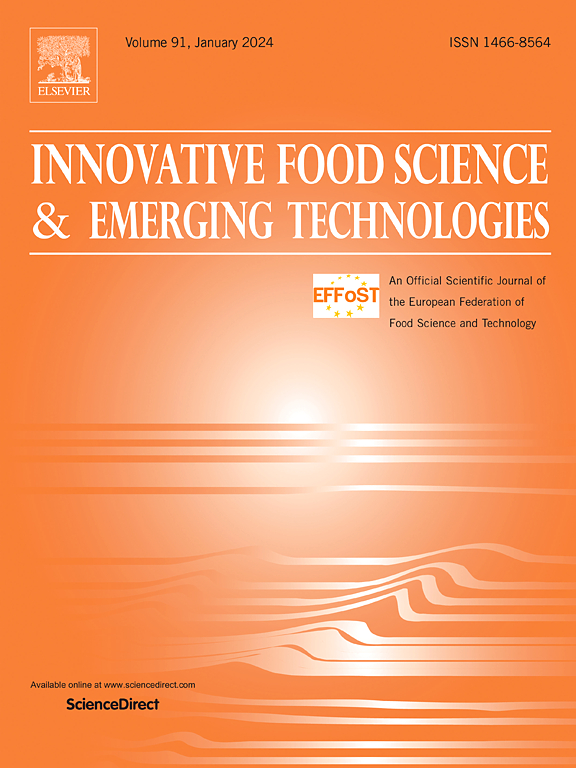pH值变化结合高压均质化诱导空气-水界面的重塑:大豆分离蛋白的结构和粘度变化对界面性质的影响
IF 6.8
1区 农林科学
Q1 FOOD SCIENCE & TECHNOLOGY
Innovative Food Science & Emerging Technologies
Pub Date : 2025-06-25
DOI:10.1016/j.ifset.2025.104097
引用次数: 0
摘要
大豆分离蛋白(SPI)的高粘度限制了其在多相胶体体系中在空气-水界面的性能。由于蛋白质的结构和聚集状态强烈影响其界面行为,本研究探讨了SPI的物理化学性质对其界面吸附机制的影响,特别侧重于扩大其在泡沫或胶体等软性食品材料中的应用。通过pH位移(pH 9)和高压均质(60、80和100 MPa)的联合使用,获得了具有高界面活性的低粘度SPI。该处理(100 MPa)促进了蛋白质的展开,减小了平均粒径,从而降低了位阻和内摩擦。结果,与未处理的SPI相比,处理后的SPI粘度(16.9 mPa·s)降低。这些结构变化降低了SPI的表面张力,从而加快了空气-水界面的渗透和重排速度,提高了SPI的界面活性。相关分析进一步表明,较小的、更灵活的和无序的蛋白质通常比较大的、更刚性的和有序的蛋白质表现出更好的界面特性。本研究为SPI的结构、粘度和界面行为之间的相互作用提供了新的见解,为提高其在泡沫基食品中作为界面稳定剂的使用提供了理论基础。本文章由计算机程序翻译,如有差异,请以英文原文为准。

pH shift combined with high-pressure homogenisation induced remodelling of the air-water interface: Effect of structural and viscosity changes of soy protein isolate on interfacial properties
The high viscosity of soy protein isolate (SPI) limits its performance at the air-water interface in multiphase colloidal systems. Since structure and aggregation state of proteins strongly influence their interfacial behaviour, this study explores the impact of the physicochemical properties of SPI on its interfacial adsorption mechanism, with a particular focus to broaden its applications in soft food materials, such as foams or colloids. Low-viscosity SPI with high interfacial activity was obtained through the combined use of pH shift (pH 9) and high-pressure homogenisation (60, 80, and 100 MPa). This treatment (100 MPa) promoted protein unfolding and reduced average particle size, thereby lowering steric hindrance and internal friction. As a result, viscosity (16.9 mPa·s) decreased in treated SPI compared to untreated SPI. These structural changes reduced surface tension of SPI, which in turn accelerated the rate of penetration and rearrangement at the air-water interface, and improved interfacial activity in SPI. Correlation analyses further showed that smaller, more flexible, and disordered proteins generally exhibited better interfacial properties compared to larger, more rigid, and ordered proteins. This study provides new insights into the interplay between structure, viscosity, and interfacial behaviour of SPI, providing a theoretical basis for improving its use as an interfacial stabiliser in foam-based-foods.
求助全文
通过发布文献求助,成功后即可免费获取论文全文。
去求助
来源期刊
CiteScore
12.00
自引率
6.10%
发文量
259
审稿时长
25 days
期刊介绍:
Innovative Food Science and Emerging Technologies (IFSET) aims to provide the highest quality original contributions and few, mainly upon invitation, reviews on and highly innovative developments in food science and emerging food process technologies. The significance of the results either for the science community or for industrial R&D groups must be specified. Papers submitted must be of highest scientific quality and only those advancing current scientific knowledge and understanding or with technical relevance will be considered.

 求助内容:
求助内容: 应助结果提醒方式:
应助结果提醒方式:


